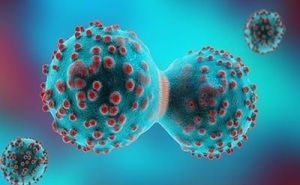Dec 11 2018
A new and novel class of nanomaterials could help improve cancer detection, believes a physicist in the College of Arts and Sciences at Syracuse University.
 A digital illustration of a cancer cell undergoing mitosis (Image credit: Christoph Burgstedt/Shutterstock.com)
A digital illustration of a cancer cell undergoing mitosis (Image credit: Christoph Burgstedt/Shutterstock.com)
Physics professor Liviu Movileanu produces microscope sensors that are capable of detecting, characterizing, and analyzing protein-protein interactions (PPIs) in blood serum. The data obtained from PPIs could prove very useful to the biomedical sector, as scientists seek to annul proteins that enable the growth and spread of cancer cells.
Movileanu’s latest results have been the topic of a paper in Nature Biotechnology (Springer Nature, 2018), co-authored by Avinash Kumar Thakur, a PhD student. Their work was supported by the National Institutes of Health (NIH) through a four-year, $1.17 million grant award.
Detailed knowledge of the human genome has opened up a new frontier for the identification of many functional proteins involved in brief physical associations with other proteins. Major perturbations in the strength of these PPIs lead to disease conditions. Because of the transient nature of these interactions, new methods are needed to assess them.
Liviu Movileanu, Professor of Physics, College of Arts and Sciences, Syracuse University.
Enter Movileanu’s lab, where a special class of biophysical tools referred to as nanobiosensors are designed, created, and optimized. These pore-based, highly sensitive tools are capable of detecting mechanistic processes, like PPIs, at the single-molecule level.
Although PPIs can take place all over in the human body, they cannot be easily detected with current techniques because they (that is, the PPIs that affect cancer development and cell signaling) last just approximately a millisecond.
In response to this, Movileanu created a hole in the cell membrane—an aperture called a nanopore—via which he shoots electric current. As proteins go through or come close to the nanopore, there is a change in the intensity of the electric current. Such changes allow Movileanu to establish the properties of individual proteins and eventually their identity.
This is not a novel concept and was initially expressed in the 1980s. However, it was only recently that researchers have started to develop and characterize nanobiosensors on a commercial scale to detect various nanoscale materials such as sugars, DNA, toxins, and explosives. Movileanu believes that his real-time methods will be able to detect cancers before they spread in the human body.
Lymphocytic leukemia—a common and aggressive disease—is one type of cancer in which Movileanu is specifically interested in. This disease first begins in the bone marrow and then spills into the bloodstream.
Usually, leukemia spiral out of control because they do not mature and die in a proper manner.
Leukemia cells build up in the bone marrow and crowd out normal, healthy cells. Unlike other cancers, which usually start in the breasts, colon or lungs [and spread to the bone marrow], lymphocytic leukemia originates in the lymph nodes, hence the name.
Liviu Movileanu, Professor of Physics, College of Arts and Sciences, Syracuse University.
Over the summer, NIH awarded another four-year grant to Movileanu—his third million-dollar one so far—to develop nanobiosensors. This latest project involves coworkers at SUNY Upstate Medical University, headed by Michael Cosgrove G’93, G’98, associate professor of biochemistry and molecular biology.
Movileanu’s projects are part of a growing field known as interactomics, which applies computational and experimental methods for studying interactions—and the outcomes of those interactions—between proteins.
“The data gleaned from a single protein sample is immense,” stated Movileanu, a member of the Biophysics and Biomaterials research group in the Department of Physics. “Our nanostructures allow us to observe biochemical events in a sensitive, specific and quantitative manner. Afterward, we can make a solid assessment about a single protein sample.”
In the future, Movileanu intends to analyze PPIs in more intricate biological samples, like tissue biopsies and cell lysates (fluid-containing “crumbled” cells).
“If we know how individual parts of a cell function, we can figure out why a cell deviates from normal functionality toward a tumor-like state,” states Movileanu, who received his PhD in experimental physics from the University of Bucharest in Romania. “Our little sensors may do big things for biomarker screening, protein profiling and the large-scale study of proteins [known as proteomics].”
In June, Movileanu presented at the first Northeast Nanomaterials Meeting of the American Chemical Society (ACS)’s Northern New York Section, conducted in Lake Placid. He has since reprised his ACS talk at Brown and Clarkson universities and at the 15th annual International Conference on Flow Dynamics in Sendai, Japan.